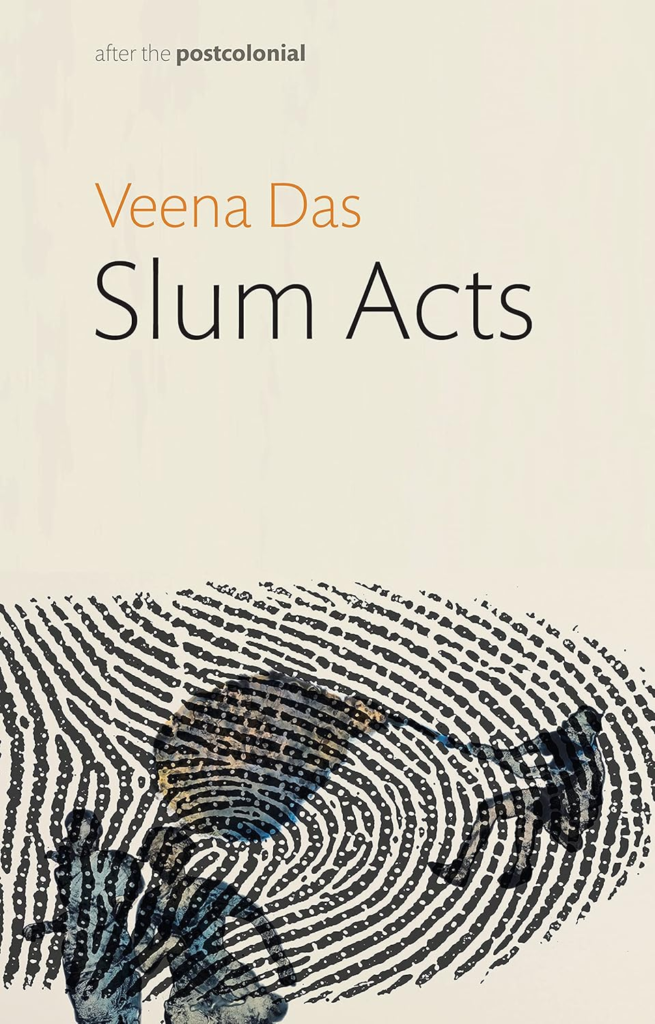
In her quest to understand the relationship between extreme violence and how it seeps into everyday life, Veena Das has written yet another impressive book. Das in Slum Acts (After the Postcolonial) (published by Polity Press in 2022) focuses on torture, brutality, police procedures, and legal proceedings in contemporary India, where the security apparatus and its power have increased unprecedentedly. In her earlier works, Das has explored the 1947 India Partition, the 1984 massacre of Sikhs in Delhi, the 1984 Bhopal gas tragedy, and the 1990 Babri Masjid demolition through the ideas of critical events and their everyday lives. The present book takes us to the low-income enclaves of Delhi and Mumbai, where she has conducted long-term ethnography along with critical engagement with legal judgments, memoirs, data archives, and literary works to understand: ‘Why are we less haunted by the apparatus of a democracy that carries on systematic torture than the apparatus of the totalitarian state’ (p. 113).
Studying small events, including ‘identifying suspects, interrogations, production of police documents, witness statements, court hearings, postponements, compromises’ (p. 3) and minor actors such as torture victims, police informers, policemen and land mafia, Das takes us into the underbelly of the massive legal-bureaucratic institution. To delve deeply, she asks ‘searing questions: ‘Why is torture practised in a democracy, why does it take weeks to get an FIR registered when my child fails to return home, how can we live with the knowledge that we gave false evidence under pressure from the police?’ (p. 7) For Das, these questions help throw new provocations for social theory in terms of ‘three specific issues: (a) the distinction between so-called civilized and barbaric violence; (b) locating alternate genealogies for theories of sovereignty; and (c) inordinate knowledge’ (ibid). Inordinate knowledge here, according to Das, is: ‘overwhelming knowledge borne with fortitude or with the desire to flee, but always more than simply archived or bare knowledge’ (p. 70).
The book is divided into five chapters, including the introduction and conclusion. The first chapter defines various concepts, including slums and how they are imagined, violence and its various forms, including civilized and savage violence. The idea of sovereignty and its alternate genealogies are discussed using the Vedic story of Mitra-Varuna. The second chapter details how violent the state is and how scholars frame events. Das notes that over the years, scholarly writing has become closer to the state’s voice rather than an alternative way of writing. Based on primary data, the chapter also uncovers the confessions and bail petitions as legal fictions, including counterfactuals, chromotrope and logical elements. This chapter is special because Das also analyses the dairy of an undertrial who was later acquitted. This book is also dedicated to the same person. The chapter shifts the focus from the legal field to the world of police and its accomplices. Das takes us on the journey of ordinary violence and how police apparatus navigates the narrow lanes of Delhi and Mumbai’s slums with the help of informers and mafias. The fourth chapter brings together four vignettes from Das’s fieldwork, where she discusses the extreme violence and possibility of life in unstable places. The concluding chapter raises many questions, including how democracies use clean torture, which is not visible on the body but causes wounds that may not heal.
In her analysis, Das explores the complex and intricate workings of terror laws put in place to protect India’s “sovereignty and territorial integrity.” She methodically examines documents that reveal instances of police tampering, falsifications, contrived incidents, and coercion of witnesses to extract false confessions. Through his detailed examination, Das uncovers the deceptive nature of these laws and the severe implications they have for the integrity of India’s criminal justice system. In her analysis, Das delves deep into the inner workings of these laws, weaving them with human existence and highlighting how they can be misused and abused, leading to severe consequences for individuals caught up in the justice system. Das’s work sheds light on the life of such laws through the ideas of legal truth and legal fiction.
Das brings to the light many cases, including information about incidents taking place in prisons, police stations, or locations where individuals were mistreated, or children trafficked and how this information was disseminated throughout communities in a discreet manner and inverted veiled language. People would share information in whispers, make implications during disputes, or use suggestive language to hint at a hidden reality. These occurrences were often hidden from view, and the information about them was sometimes masked behind words that had a deeper meaning.
One of the arguments Das makes in this book is that there is no fixed figure and ground relation between a particular social institution and its embodiment – often, it is through the traces of the state within the family or in the everyday events of low-income neighbourhoods, that one deciphers aspects of the state, its founding and re-founding moments, especially given the episodic character of sovereign power. Sometimes, these moments are found in documents stored in a family’s rusted trunks, in old wounds on the body, as part of the habitat emerging over the years and interlaced in jokes, stories, and gestures.
Das’s argument delves into the intricate connection between violence, power, and humanity, detailing how the concept of violence not only affects the character of democracy and sovereign power but also permeates into the material of everyday life, shaping different forms of living. The question of how humans become ‘inhuman’ is vital and demands careful attention. The state’s violence is a potent force that can fundamentally alter the nature of society, leaving an indelible impact on people’s lives. Understanding its impact is crucial for creating a fair and just world. Das’s insightful observations offer a valuable lens through which we can examine the complex interplay between power, violence, and humanity, providing a deeper understanding of their impact on our lives.
***
Chakraverti Mahajan teaches Anthropology at the University of Delhi.
